#CRM Admin Dashboard
Explore tagged Tumblr posts
Text
The Evolution of Bootstrap Admin Template
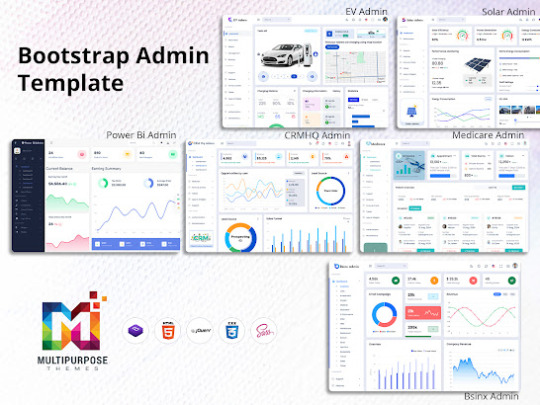
Bootstrap has become one of the most popular open-source frontend frameworks for developing responsive and mobile-first websites and web applications. Its easy-to-use grid system, prebuilt components, JavaScript plugins enable rapid UI/UX prototyping and development. Bootstrap Admin Template capabilities also make it easy to customize the look and feel of websites and dashboards.
These capabilities have made Bootstrap the go-to framework for admin dashboard templates as well. Developers can use Bootstrap to quickly scaffold admin panels and dashboards with common UI elements like navigation menus, data tables, charts, UI widgets etc.
In this article, we go through some of the best Dashboard UI collections focusing innovative designs and rich feature-sets suiting modern application requirements.
EV Admin - The Electric Vehicle Charging Station Admin Template
EV mobility and electric vehicles are becoming mainstream fast. And the EV ecosystem requires robust software infrastructure for managing charging stations, driver apps, and operational analytics. EV Admin is a purpose-built UI Dashboard for EV charging point operators.
The visually appealing and functionally rich Bootstrap Admin Panel provides all critical modules like driver and charging point management, real-time operations monitoring, analytics and reporting, billing and invoicing and lots more. The developer-friendly codebase ensures easy integration with real-time data sources and EV management APIs.
BsinX Ultimate Admin Template for Web Apps and SaaS Products
Bsinx Ultimate is one of the most versatile and complete admin template collections with 100+ ready templates suiting various industries and use cases. From web app dashboards, CRMs, Project Management tools to eCommerce Smart Sales Admin Panel, Crypto trading platforms and more, Bsinx Ultimate has pre-built templates for them all.
The Bootstrap Admin Template is based on latest Bootstrap 5 and come with gorgeous UI kits having hundreds of integrated widgets and UI components. The developer-friendly code ensures easy integration with backends. And extensive documentation guides customization and deployment. For startups and developers planning web apps and SaaS products, Bsinx Ultimate is the best Bootstrap Admin Theme available today.
Medicare Admin - Template for Healthcare and Insurance Web Applications
Healthcare web apps have complex workflows and data visualizations needs. Medicare Admin eases rapid development of such applications with its purpose-built modules for patient management, medical billing, insurance claims processing, scheduling, reporting and more.
The Medical Master Dashboard has beautiful and intuitive UI matching modern healthcare application standards. And developer-friendly code ensures easy integration with healthcare APIs and databases.
CRMHQ Admin - Admin CRM for Client Management Apps
Tailwind CSS is a versatile utility-first framework rapidly gaining developer mindshare as an alternative to Bootstrap. CRMHQ Admin leverages Tailwind CSS classes to build a superb CRM Dashboard Template with modules for account, contact and opportunity management, email integration, reporting and roles-based access control.
The customizable UI kit comprising Tailwind CSS elements streamlines branding and personalization. Scalable code and detailed documentation ensures easy deployment across devices and integration with backends. For startups planning client management apps, CRMHQ Admin is the best Tailwind CSS admin template.
Power Bi Admin - Template for Project and Task Management Web Apps
Effective project management is critical for organizations across industries. Power Bi Admin provides a readymade Bootstrap Admin Template to build feature-rich work management applications. It includes kanban boards, Gantt charts, rich text editors, calendars, messaging and other elements specifically for collaborating on projects and tasks.
Easy customization and developer-friendly code allows tweaking Power Bi Admin’s flexible design system to specific needs. The Bootstrap powered responsive template seamlessly adapts across devices and screen sizes. For SMBs, agencies and enterprises needing custom work management apps, Power Bi Admin is the perfect template for rapid development.
Final Words
The Bootstrap ecosystem offers a rich variety of Bootstrap Admin Template for quickly building dashboards across verticals and specializations. While they share the common strengths of Bootstrap's responsive grid, UI widgets and themes, the templates focus on domain-specific use cases with ready modules. For developers and businesses, opting the right template can significantly accelerate rollout of custom admin panels and web apps.
#Dashboard UI#UI Dashboard#Master Dashboard#Admin CRM#Admin Dashboard UI#Bootstrap Admin Panel#Bootstrap Admin Theme
0 notes
Text
Mplify - Versatile Bootstrap 4 Admin Template by Thememakker
Mplify Admin makes the development process easy and fast for you and aims to help you implement your idea in real time.
Product Highlights
Mplify is a fully professional, responsive, modern, multi-purpose, and feature-rich admin template. It can be used to create various websites, admin templates, admin dashboards, backend websites, CMS, CRM, blogs, business websites, timelines, and portfolios. This versatility makes it an ideal choice for developers looking to build functional and aesthetically pleasing web applications efficiently.
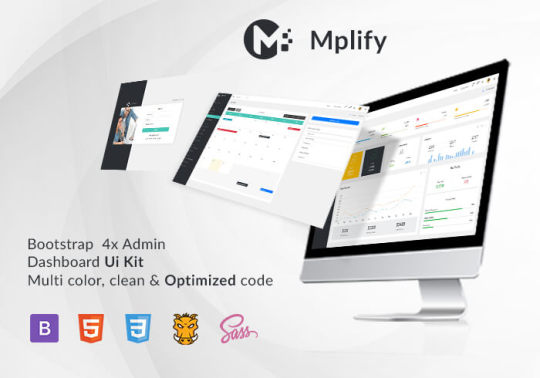
Key Features
Bootstrap 4.3.1: Ensures compatibility and modern design standards.
jQuery 3.3.1: Offers extensive plugins and support.
Built-in SCSS: Provides more flexibility and control over styles.
Light & Dark Full Support: Allows users to switch between light and dark themes.
RTL Full Support: Right-to-left language support for global accessibility.
W3C Validate Code: Ensures high coding standards and practices.
Mobile and Tablet Friendly: Responsive design for all devices.
Treeview: For hierarchical data display.
Drag & Drop Upload: Simplifies file uploading processes.
Image Cropping: Integrated tools for editing images.
Summernote: Rich text editor integration.
Markdown: Support for markdown formatting.
Beautiful Inbox Interface: User-friendly email management.
User-Friendly Chat App: Built-in chat application.
Scrum & Kanban Taskboard: Task management tools.
Add Events to Your Calendar: Event management capabilities.
File Manager: Efficient file organization and management.
Blogging: Tools to manage and create blog posts.
Testimonials: Features to showcase user testimonials.
Maintenance: Tools to manage and schedule maintenance.
Team Board: Collaboration tools for team management.
Search Result: Enhanced search functionalities.
Beautiful Pricing: Elegant pricing tables and plans.
Contact List & Grid: Efficient contact management.
User Profile: Customizable user profiles.
Extended Forms: Advanced form functionalities.
Clean Widgets: A variety of clean, modern widgets.
Technical Specifications
Bootstrap 4.3.1
Bootstrap 4.3.1 is a powerful front-end framework for faster and easier web development. It includes HTML and CSS-based design templates for typography, forms, buttons, tables, navigation, modals, image carousels, and many other interface components, as well as optional JavaScript plugins. Mplify leverages Bootstrap 4.3.1 to ensure a consistent and responsive design across all devices.
jQuery 3.3.1
jQuery is a fast, small, and feature-rich JavaScript library. It makes things like HTML document traversal and manipulation, event handling, and animation much simpler with an easy-to-use custom API integration that works across a multitude of browsers. Mplify includes jQuery 3.3.1 to provide enhanced functionality and interactivity to your applications.
Built-in SCSS
SCSS is a preprocessor scripting language that is interpreted or compiled into CSS. It allows you to use variables, nested rules, mixins, inline imports, and more, all with a fully CSS-compatible syntax. With SCSS, Mplify offers a more powerful and flexible way to manage styles.
Light & Dark Full Support
Mplify comes with built-in support for light and dark themes, allowing users to switch between these modes based on their preferences. This feature enhances user experience and accessibility, especially in different lighting conditions.
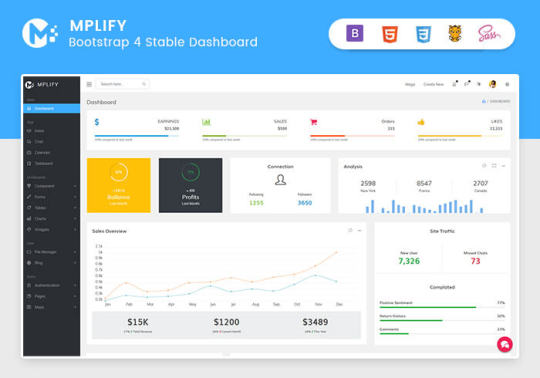
RTL Full Support
For developers targeting global audiences, Mplify provides full right-to-left (RTL) language support. This feature ensures that languages like Arabic, Hebrew, and Persian are properly displayed, making the template versatile and inclusive.
W3C Validate Code
The World Wide Web Consortium (W3C) sets the standards for web development. Mplify adheres to W3C's coding standards, ensuring that the template is built with clean, valid code, which improves browser compatibility, SEO, and overall performance.
Mobile and Tablet Friendly
In today's mobile-first world, having a responsive design is crucial. Mplify is designed to be fully responsive, ensuring that your mobile application looks great and functions seamlessly on all devices, including desktops, tablets, and smartphones.
Applications
Mplify’s versatile design and feature set make it suitable for a wide range of applications across various industries. Here are some key applications:
Admin Dashboards
Mplify provides a robust framework for building admin dashboards. With its extensive set of UI components, charts, forms, and tables, you can create comprehensive dashboards that provide valuable insights and data visualization.
CMS (Content Management Systems)
With features like blogging, file management, and user profile management, Mplify can be used to build powerful CMS platforms. Its clean widgets and beautiful interface ensure that the content management experience is both efficient and enjoyable.
CRM (Customer Relationship Management)
Mplify’s built-in tools for managing contacts, scheduling events, and maintaining communication through a chat app make it an excellent choice for developing CRM systems. These features help businesses manage customer interactions and data effectively.
Business Websites
The multi-purpose nature of Mplify allows it to be used for various business websites. Whether you need a portfolio, a blog, or a corporate website, Mplify provides the necessary tools and components to create a professional online presence.
Blogging Platforms
With integrated tools like Summernote for rich text editing and Markdown support, Mplify is ideal for creating blogging platforms. The beautiful inbox interface and testimonial features enhance the blogging experience, making it easy to manage and publish content.
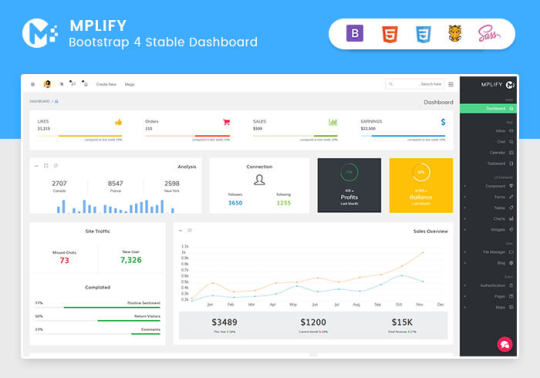
Benefits
Easy and Fast Development
Mplify is designed to streamline the development process. With its pre-built components and templates, you can quickly assemble functional and aesthetically pleasing applications. This reduces development time and costs, allowing you to focus on implementing your ideas in real time.
Professional and Modern Design
Mplify offers a clean, modern design that is both professional and user-friendly. The template includes a variety of customizable widgets and components that adhere to the latest design standards, ensuring your application looks polished and up-to-date.
Comprehensive Feature Set
From task management tools like Scrum and Kanban boards to extensive form functionalities, Mplify provides a wide range of features that cater to various needs. This comprehensive feature set makes it a versatile solution for different types of projects.
Responsive and Mobile-Friendly
With Mplify, you can ensure that your application is accessible on all devices. Its responsive design adapts to different screen sizes, providing a seamless user experience on desktops, tablets, and smartphones.
Global Accessibility
Mplify’s RTL support and multi-language capabilities make it suitable for global applications. This feature ensures that your application can cater to users from different regions, enhancing its reach and usability.
Regular Updates and Support
When you purchase a license for Mplify, you receive all future updates for free. This ensures that your application remains up-to-date with the latest features and improvements. Additionally, Mplify provides excellent customer support to assist with any issues or queries.
Challenges and Limitations
Learning Curve
While Mplify is designed to be user-friendly, there may be a learning curve for beginners who are not familiar with Bootstrap or jQuery. However, comprehensive documentation and community support can help mitigate this challenge.
Customization
Although Mplify offers a wide range of customization options, extensive customization may require advanced knowledge of SCSS and JavaScript. This could be a limitation for developers who are not well-versed in these technologies.
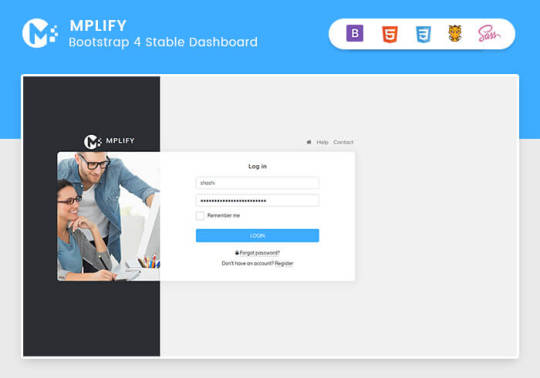
Performance
As with any feature-rich template, there is a potential for performance issues if too many components and plugins are used simultaneously. It is important to optimize the application and selectively use features to maintain optimal performance.
Latest Innovations
Enhanced UI Components
Mplify continues to evolve with regular updates that introduce new and improved UI components. These enhancements ensure that your application remains modern and functional.
Advanced-Data Visualization
Recent updates have focused on improving data visualization capabilities. With enhanced charting tools and interactive elements, Mplify allows for more dynamic and engaging data presentation.
Integration with New Technologies
Mplify is continuously updated to integrate with the latest web technologies. This ensures compatibility with new frameworks and libraries, providing developers with more tools to build advanced applications.
Future Prospects
AI and Machine Learning Integration
The future of Mplify may include integration with AI and machine learning tools. This would enable developers to build more intelligent and automated applications, enhancing user experience and functionality.
Expanded Plugin Support
As the web development landscape evolves, Mplify is likely to expand its plugin support. This will provide developers with more options for extending the functionality of their applications.
Improved Accessibility Features
Mplify is expected to continue enhancing its accessibility features. This includes better support for assistive technologies and compliance with accessibility standards, ensuring that applications built with Mplify are inclusive for all users.
Comparative Analysis
Versus Other Bootstrap Templates
When compared to other Bootstrap templates, Mplify stands out due to its comprehensive feature set, modern design, and extensive customization options. While other templates may offer similar components, Mplify's unique features like RTL support and advanced task management tools give it an edge.
Versus Custom Development
Opting for a pre-built template like Mplify can significantly reduce development time and costs compared to custom web development. While custom development offers more flexibility, Mplify provides a robust foundation that can be easily customized to meet specific needs.
User Guides and Tutorials
Getting Started with Mplify
Installation: Download and install Mplify from the official website or marketplace.
Configuration: Configure the template settings according to your project requirements.
Customization: Use the built-in SCSS files to customize the styles and appearance.
Integration: Integrate Mplify with your backend systems and databases.
Deployment: Deploy your application on your preferred hosting platform.
Advanced Customization Techniques
SCSS Variables: Use SCSS variables to easily change colors, fonts, and other styles.
JavaScript Customization: Extend the functionality by adding custom JavaScript code.
Component Modification: Modify existing components or create new ones to meet specific needs.
Performance Optimization: Optimize the performance by minifying CSS and JavaScript files, and selectively loading components.
Conclusion
Mplify is a powerful, versatile, and user-friendly Bootstrap 4 admin dashboard template. It offers a wide range of features and customization options, making it suitable for various applications, from admin dashboards to business websites. With its modern design, responsive layout, and extensive documentation, Mplify simplifies the development process, allowing developers to implement their ideas in real time efficiently.
Whether you are building a CMS, CRM, or a personal blog, Mplify provides the tools and flexibility needed to create a professional and functional web application. Its ongoing updates and support ensure that your projects remain current and compatible with the latest web technologies.
#Mplify Admin#Bootstrap 4.3.1#jQuery 3.3.1#SCSS#Light & Dark Theme#RTL Support#W3C Validation#Responsive Design#Admin Template#Admin Dashboard#CMS#CRM#Blogging#Business Websites#Web Development#UI Components#Data Visualization#AI Integration#Machine Learning#Accessibility Features#Task Management#File Management#Rich Text Editor#Markdown Support#User Profiles#Performance Optimization#Web Technologies#Custom Development#Web Application Development#Front-end Framework
0 notes
Text

Magtec Business Software.
#crm#erp#business#software#marketing#sales#technology#b#salesforce#css#crmsoftware#digitalmarketing#ecommerce#bootstrap#mobileapp#dashboard#adminpanel#dynamics#cloud#envato#seo#erpsoftware#webapp#o#admin#webkit#admindashboard#management#m#customerrelationshipmanagement
0 notes
Text
How to Build an Instacart Clone App in 5 Easy Steps
I’ve always believed that the on-demand economy isn’t just a trend—it’s a transformation. And if you're anything like me, you've noticed how grocery delivery has gone from a convenience to an expectation. That’s why Instacart clone app development has become such a hot topic among enterprises looking to enter or expand in the online grocery delivery market.
So, whether you're a business unit manager exploring new digital channels or an enterprise leader looking for scalable growth opportunities, let me walk you through how to build an Instacart clone app solution in five simple, strategic steps.

Step 1: Understand the Core Features of Instacart
Before writing a single line of code or hiring a dev team, I always start by breaking down what makes Instacart work so well. Here’s what I look for:
User-friendly interface for quick grocery selection
Real-time inventory updates
Multiple payment gateways
Advanced search and filters
Order tracking & delivery scheduling
Ratings and reviews
Admin dashboard & analytics
This core list becomes the foundation for any Instacart clone app development strategy. I map out which features are must-haves for launch and which ones can be added as part of a future update.
Step 2: Choose the Right Tech Stack
Next, I focus on the technology. A good Instacart clone app solution must be scalable, secure, and responsive. Here's a sample stack I usually recommend:
Frontend: React Native or Flutter (for both iOS and Android)
Backend: Node.js with Express or Django
Database: PostgreSQL or MongoDB
Cloud & Hosting: AWS or Google Cloud
Notifications: Firebase or OneSignal
Payments: Stripe, Razorpay, or PayPal
When choosing a tech stack, I always keep in mind the long-term goals of the business—speed is great, but sustainability is better.
Step 3: Partner with the Right Development Team
This part can’t be rushed. Whether you have an internal IT team or need to hire an external agency, experience with Instacart clone app development is non-negotiable. I look for teams that:
Have a solid portfolio of on-demand apps
Offer UI/UX design, backend development, and post-launch support
Understand third-party integrations (like maps, payment gateways, and CRMs)
If you’re considering a white-label Instacart clone app solution, make sure it's customizable and comes with full source code.
Step 4: Launch with a Localized MVP
Rather than go big right away, I always suggest launching a minimum viable product (MVP) in a specific region. This allows me to:
Test core features with real users
Collect feedback for improvements
Optimize delivery logistics and partnerships
Build local brand awareness
A soft launch helps in shaping the app based on real-world data—not assumptions. It also reduces risk and improves ROI in early phases.
Step 5: Scale with Data and Marketing Automation
After the MVP stage, it's time to scale. I usually focus on:
User acquisition via paid campaigns, SEO, and social media
Loyalty programs to retain repeat users
Analytics dashboards to track KPIs
Marketing automation tools for email, push notifications, and re-engagement
A robust Instacart clone app solution should allow integration with CRMs, marketing tools, and performance analytics. This ensures that as the business grows, the app grows with it.
Final Thoughts
Building an app like Instacart might sound complex at first, but with the right approach and a clear roadmap, it's completely doable—even for enterprise teams without prior tech experience. I’ve seen firsthand how investing in Instacart clone app development can unlock new revenue streams, deepen customer loyalty, and bring real operational efficiencies.
So if you're ready to deliver convenience at scale, now’s the perfect time to build your Instacart clone app solution—and I’d love to help you take the first step.
0 notes
Text
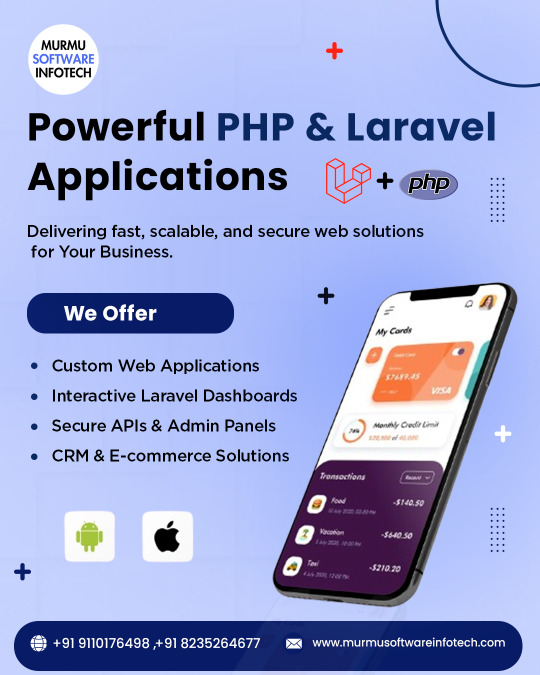
Powerful PHP & Laravel Applications Build scalable, secure, and high-performing web applications tailored to your business!
✅ Custom Web Apps ✅ Laravel Dashboards ✅ Secure APIs & Admin Panels ✅ CRM & E-commerce Solutions
📱 For Android & iOS 🌐 Visit: www.murmusoftwareinfotech.com 📞 +91 9110176498 | +91 8235264677
💡 Let’s take your idea to code, and your code to the cloud!
#LaravelDevelopment #PHPDeveloper #CustomWebApps #WebDevelopmentServices #LaravelExperts #CRMSolutions #EcommerceSolutions #WebAppsIndia #MurmuSoftwareInfotech #SecureWebApps #StartupSolutions #TechForBusiness #LaravelDashboard #AppDevelopmentRanchi
0 notes
Text
Unlock Seamless Business Communication with Cloud Telephony Solutions
In the era of digital transformation, businesses are rethinking how they communicate—both internally and externally. Traditional phone systems are giving way to smarter, more agile solutions like cloud-based telephony. Also known as VoIP (Voice over Internet Protocol), this technology allows companies to manage calls, messages, and meetings through the internet, without relying on bulky hardware or outdated infrastructure.
Cloud telephony enables organizations to operate more efficiently, reduce costs, and support hybrid work environments—all while enhancing the customer experience.
What Is Cloud Telephony?
Cloud telephony is a virtual phone system hosted in the cloud. Instead of using traditional landlines, it routes calls over the internet. Employees can make and receive calls using their laptops, smartphones, or IP phones—anywhere in the world, as long as they have a stable internet connection.
This flexibility has made cloud telephony the preferred choice for startups, growing businesses, and enterprises looking to stay ahead in a competitive landscape.
Top Advantages of Cloud-Based Telephony
1. Reduced Operational Costs Say goodbye to expensive phone hardware, cabling, and maintenance. With cloud telephony, businesses only pay for what they need—making it a highly cost-effective solution.
2. Greater Flexibility & Mobility Cloud systems support remote and hybrid work with ease. Teams can stay connected through mobile apps, web portals, and softphones—ensuring business continuity from any location.
3. Effortless Scalability Whether you're adding new employees or opening a branch office, cloud telephony makes it easy to expand your phone system without major upgrades or installation delays.
4. Advanced Features at Your Fingertips From call forwarding, auto-attendants, voicemail-to-email, and call analytics, to CRM integrations—cloud telephony offers a rich set of tools that boost productivity and customer engagement.
5. High Availability & Reliability Cloud phone systems are designed with redundancy and backup in mind. In the event of a power or network outage, calls can be rerouted automatically to ensure uptime.
6. Centralized Management Admins can manage the entire phone system from a single dashboard—monitoring call performance, user activity, and system settings in real-time.
Who Benefits from Cloud Telephony?
Customer Support Centers: Efficient call routing and real-time reporting
Sales Teams: Click-to-call integrations and mobile flexibility
Remote Workforces: Reliable communication tools for on-the-go employees
Startups & Growing Businesses: Scalable communication without large capital investment
Conclusion
Cloud-based telephony is transforming the way modern businesses communicate. It eliminates the limitations of legacy phone systems and delivers a secure, scalable, and cost-effective solution tailored for today’s fast-paced work environment.
If you're looking to future-proof your business communications and support a more agile workforce, switching to cloud telephony is a smart move. It’s not just about better calls—it’s about smarter, more connected business operations.
0 notes
Text
Multi-level Marketing Software That Simplifies Network Growth.
In an era where automation and data-driven decision-making define success, businesses engaged in network marketing are increasingly turning to Multi-level marketing software to streamline operations. This powerful digital infrastructure simplifies commission calculations, member tracking, sales forecasting, and team hierarchy management — making the life of MLM companies easier and more efficient.

Understanding Multi-level Marketing Software
Multi-level marketing software is a digital system designed to manage the structure, finances, and operations of MLM businesses. Whether operating on a binary, matrix, unilevel, or hybrid plan, such platforms offer high flexibility, data security, and real-time insights.
At its core, the software supports:
Member onboarding and genealogy tree creation
Automated commission and bonus calculations
Product order and inventory tracking
Income reporting and tax documentation
Real-time dashboards for agents and admin
Why MLM Software Development Matters
Investing in professional MLM software development means ensuring your business has a tailored solution that adapts as you grow. Generic tools often lack the scalability and logic customization required in diverse marketing plans. FeatureGeneric CRM ToolsCustom MLM SoftwareMLM Plan FlexibilityLimited or NoneFully CustomizableReal-time Commission TrackingNot AvailableIntegrated and AutomatedAgent Tree ManagementNot SupportedDynamic Genealogy StructuresScalabilityMay lag on large networksOptimized for network growth
Real Experiences From the Field
"The transition to a modern multi-level marketing software helped reduce our admin workload by 70% and improved accuracy in commission payouts." — Priya D., Network Marketing Manager, Mumbai
"We moved away from spreadsheets after realizing the cost of manual errors. A robust MLM software development solution saved us hours every week." — Sandeep T., Director at Herbal Product Company
Key Benefits for Network-Based Businesses
Data Accuracy: Automated calculations reduce human errors
Transparency: Members have access to their earnings and downlines
Growth Enablement: Scalability supports rapid network expansion
Compliance: Integrated tax and financial reports simplify auditing
Frequently Asked Questions (FAQ)
Q: Can I use multi-level marketing software for any MLM plan? A: Yes. Whether you operate under binary, matrix, or unilevel, most modern tools support all major structures.
Q: Is custom MLM software development expensive? A: Costs vary, but considering the time saved, error reduction, and better business insights, it's often a worthwhile investment.
Q: Is it cloud-based or desktop only? A: Most platforms today are cloud-based, ensuring access from anywhere with data protection features.
Q: How long does it take to implement? A: Depending on complexity, implementation can take anywhere from 1 week to 2 months.

Conclusion
Businesses in the network marketing sector can no longer rely on outdated systems or manual calculations. With the rise of secure, efficient, and scalable MLM software development, companies now have the opportunity to focus on strategy rather than admin.
By adopting a robust multi-level marketing software solution, organizations can simplify network management, ensure timely commissions, and support seamless growth — all while maintaining compliance and transparency.
0 notes
Text
Laravel Web Development Agency & Magento Integration Experts | WebbyTroops
In today's rapidly evolving digital economy, companies need robust, scalable, and customizable web solutions that yield actual outcomes. You might be creating a tailored application from the ground up or scaling your ecommerce site. Either way, you need to have the right tech partner. As a top Laravel web development company and Magento solution company, WebbyTroops has been empowering startups, SMEs, and large enterprises worldwide.
From strong Laravel development in India to smooth Magento API integration, B2B ecommerce installations, and Magento customization, our team of experts is ready to drive your online presence forward.
Laravel Web Development Agency: Creating Scalable, Secure & Modern Web Applications
As a complete-stack Laravel web development company, WebbyTroops develops custom web applications that are both scalable and secure. Laravel's robust MVC structure, expressive syntax, and rich ecosystem make it the perfect framework for custom application development.
Why WebbyTroops for Laravel App Development?
Custom CRM, ERP, & portal development
RESTful APIs for mobile & third-party integration
Modular, reusable code with clean architecture
Cloud deployment & performance optimization
End-to-end support and agile development
From admin dashboards and inventory systems to SaaS platforms and eCommerce backends, we’ve helped hundreds of clients streamline operations using Laravel.
Leading Laravel Development Company in India
WebbyTroops has gained a reputation as one of the best Laravel development providers in India due to our skilled team, honest processes, and client-centric approach. Our Indian development centers enable us to provide cost-effective solutions without sacrificing quality or deadlines.
Be you in the US, UK, Europe, or Middle East, we offer dependable outsourcing and Laravel solutions on a project basis customized for your timezone and business goals.
Magento API Integration: Smarter Automation for Smarter Ecommerce
Many ecommerce companies want to integrate third-party services such as CRMs, ERPs, payment gateways, or shipping systems. That's where we step in with our Magento API integration services. We assist businesses in integrating their Magento store with necessary tools in order to automate processes and provide improved user experiences.
What We Integrate Magento With:
CRM systems (Salesforce, Zoho, HubSpot)
ERP solutions (SAP, Odoo, Microsoft Dynamics)
Logistics APIs (ShipRocket, DHL, FedEx)
Accounting & billing tools (QuickBooks, Tally)
Custom mobile or headless applications
Smooth, secure integration is guaranteed by our Magento-certified developers for real-time data transfer between platforms.
Magento B2B Development: Empowering Wholesale & Enterprise Commerce
Today's B2B buyers demand similar intuitive and quick experiences as B2C consumers. Our Magento B2B development solutions allow companies to establish rich-featured wholesale portals with features such as:
Personalized pricing by customer group
Management of bulk orders
Quote request systems & approval processes
Role-based account access
Multi-warehouse & multi-vendor management
Whatever your business type - manufacturer, wholesaler, or distributor - WebbyTroops develops Magento B2B ecommerce stores that increase efficiency and conversions.
Magento Customization Services: Designed as Per Your Business Requirements
Every two businesses are unique—your online shop shouldn't be either. Through our Magento customization services, we alter and extend basic functionalities to reflect your company, operations, and objectives.
Examples of Customization:
UI/UX theme development
Custom Magento extensions & modules
Optimizing performance & speed
Localization & multilingual support
Customizing checkout & payment process
From small modifications to full Magento rebuilds, our developers bring solutions that are strong, upgrade-safe, and future-proof.
Why WebbyTroops?
Certified Laravel & Magento specialists
10+ years of development experience
Agile approach & clear communication
Client-focused process with measurable results
End-to-end service—design, development, integration, and maintenance
Let's Build Something Great Together
No matter if you need a reliable Laravel web development agency, Magento API integration, or a custom Magento B2B store, WebbyTroops has the skill and enthusiasm to turn your idea into reality.
Reach out to us now for a complimentary consultation or project quote.
0 notes
Text
What Will I Learn in Salesforce Admin Training?
Salesforce is the world's #1 CRM platform, used by businesses of all sizes to manage customer relationships, sales processes, and internal operations. If you’re considering a career in Salesforce, becoming a Salesforce Administrator is one of the fastest and most rewarding paths. But what will you actually learn in a Salesforce Admin Training course? Let’s dive into the key topics, real-world skills, and career benefits you can expect.

Why Choose Salesforce Admin Training?
As cloud computing continues to dominate the tech landscape, Salesforce skills are in high demand. According to IDC, the Salesforce economy is expected to create over 9 million jobs worldwide by 2026. This makes Salesforce Admin Training not just relevant but essential for tech aspirants and career changers.
Whether you're searching for salesforce training courses, Sfdc courses, or wondering what a typical Salesforce course entails, this blog breaks it all down for you.
What Is a Salesforce Administrator?
Before diving into the learning outcomes, let’s clarify the role. A Salesforce Administrator is responsible for:
Managing user access and security
Customizing Salesforce to fit business needs
Automating processes using tools like Flow
Generating reports and dashboards
Maintaining data quality and compliance
This role sits at the intersection of business and technology, making it an ideal position for people with both analytical and communication skills.
Core Modules Covered in Salesforce Admin Training
1. Salesforce Basics and Navigation
You’ll start with an introduction to the Salesforce ecosystem, learning:
What is Salesforce CRM?
Cloud architecture (Sales, Service, Marketing, etc.)
Navigation through Lightning Experience
App Launcher, Tabs, and User Interface elements
This forms the foundation of every Salesforce admin’s knowledge.
2. Organization Setup
You’ll learn to configure organizational settings:
Company profile setup
Fiscal year, business hours, holidays
Locale settings and currency management
These configurations are key to aligning Salesforce with business operations.
3. User Management and Security Controls
Security is vital. In this module, you’ll explore:
Profiles and Permission Sets
Role hierarchy and Sharing Rules
Login access policies
Field-level and object-level security
Understanding this ensures the right users see the right data.
4. Standard and Custom Objects
You’ll learn the difference between built-in and custom data structures:
Standard objects like Leads, Contacts, Opportunities
Custom object creation and relationships
Lookup vs. Master-Detail relationships
Schema Builder visualization
Customizing objects is how you tailor Salesforce to business needs.
5. Data Management
Managing data is central to the administrator’s role:
Data import/export using Data Loader and Data Import Wizard
Mass updates and deletions
Duplicate rule setup
Validation Rules and Field dependencies
Clean, organized data means better decision-making.
6. Process Automation
One of the most powerful features in Salesforce Admin Training:
Workflow Rules and Actions
Process Builder (being phased out)
Flows and Flow Builder (modern automation tool)
Approval processes
Learn how to automate repetitive tasks and improve efficiency.
7. Reports and Dashboards
You’ll gain hands-on skills in business analytics:
Creating custom reports
Report types and filters
Summarized data fields
Dynamic dashboards and scheduling
These tools help teams make data-driven decisions every day.
8. AppExchange and Installed Packages
Learn how to extend Salesforce functionality:
What is AppExchange?
Installing and managing packages
Managing third-party integrations
Essential for real-world projects using third-party tools.
9. Change Management and Sandbox Testing
Admins must safely deploy changes:
What are Sandboxes and their types?
Change sets and deployment best practices
Release management
Hands-on practice ensures smooth transitions from testing to production.
Real-World Applications of Salesforce Admin Skills
Case Study: Sales Process Optimization
Scenario: A mid-size company struggles with tracking leads and converting them into opportunities.
Admin Solution:
Customized Lead object
Created lead assignment rules
Set up auto-conversion flows
Built a report to track lead conversion rates
Case Study: Automated Approvals
Scenario: A services company wants automatic approvals for project budgets.
Admin Solution:
Created approval process using Flow
Triggered email notifications for stakeholders
Set up criteria-based logic for escalation
Case Study: Dashboard for Executives
Scenario: Leadership needs a quick view of quarterly performance.
Admin Solution:
Built a dynamic dashboard
Used filters for regions and products
Scheduled automated delivery every Monday
Salesforce Certification Course Preparation
A quality Salesforce certification course doesn’t just teach concepts it prepares you for the Salesforce Administrator Certification Exam.
Certification Prep Includes:
Multiple-choice exam strategies
Mock tests and practice exams
Key focus areas (e.g., security, reports, automation)
Official exam blueprint walk-through
This is often part of comprehensive salesforce certification training programs.
📍 Looking for Salesforce Training Near You?
If you’re searching for salesforce training near me, you’ll find both in-person and virtual options. The key is to choose a program that offers:
Hands-on projects
Real-time scenarios
Instructor-led training
Job placement support
H2K Infosys is one of the few platforms offering Salesforce training with live sessions, real-time examples, and placement support to help you land jobs quickly after completing the course.
Tools and Environments You’ll Work With
In your Salesforce admin course, you’ll use:
Salesforce Lightning Experience
Data Loader
Workbench
Flow Builder
Schema Builder
Developer Console (for troubleshooting)
These tools are standard in almost all sales force training programs and help simulate real-world environments.
Career Prospects After Salesforce Admin Training
Once you complete your salesforce admin training, you can qualify for roles like:
Salesforce Administrator
CRM Analyst
Salesforce Support Specialist
Salesforce Consultant (Junior level)
Many companies also require Sfdc courses background when hiring for advanced roles like Salesforce Business Analyst or Platform App Builder.
Why Choose Salesforce Training and Placement Programs?
In the best IT training and placement in USA, you'll not only gain technical skills but also:
Build a professional resume aligned with Salesforce roles
Practice mock interviews with real-world scenarios
Gain access to job placement portals and internal referrals
Connect with certified instructors and mentors
Training with placement is ideal for career changers, fresh graduates, and anyone transitioning into tech.
Learning Outcomes: What You’ll Walk Away With
Here’s a quick summary of the Salesforce Admin Training takeaways: Skill AreaWhat You’ll LearnCRM BasicsSalesforce UI, Objects, TabsSecurityProfiles, Roles, Sharing SettingsCustomizationCustom Fields, Objects, Page LayoutsData HandlingData Import/Export, Validation RulesAutomationFlows, Approvals, Workflow RulesReportingCustom Reports, DashboardsReal ProjectsUse Cases, Automation, Reporting SolutionsCareer SupportResume Help, Mock Interviews, Job Search
You’ll also be well-prepared to pursue a salesforce certification course and begin applying for admin-level roles across industries.
Learning Path: Step-by-Step Overview
Here's what your Salesforce course journey will look like:
Week 1–2: CRM Introduction, Salesforce Setup
Week 3–4: Security, Users, and Permissions
Week 5–6: Object Customization, Data Handling
Week 7–8: Automation Tools and AppExchange
Week 9: Reporting and Dashboards
Week 10: Revision, Capstone Project, Certification Prep
Week 11–12: Resume Review, Mock Interviews, Job Placement
Industry Demand for Salesforce Admins
73% of Salesforce customers require admin roles.
Average Salesforce Admin salary in the U.S. is over $85,000/year.
Industries hiring include healthcare, retail, financial services, and government.
Companies need admins who can configure, optimize, and support Salesforce across teams. That’s why the salesforce certification training is a launchpad to a long-term career.
How H2K Infosys Can Help
H2K Infosys provides comprehensive Salesforce admin training programs tailored to real-world projects. With an emphasis on hands-on labs, mock interviews, and career mentoring, the program bridges the gap between learning and employment.
You’ll get exposure to everything from SFDC courses foundations to practical deployments, positioning you for immediate job readiness.
Key Takeaways
Salesforce Admin Training covers user setup, data management, process automation, and reporting.
The role is business-critical and offers career stability and growth.
Completing a salesforce certification course validates your skills.
Training with placement gives you a competitive edge in today’s job market.
The best IT training and placement in USA includes live projects, mentorship, and job support.
Final Thoughts
If you're ready to start a rewarding tech career, Salesforce Admin Training is a smart move. Equip yourself with the skills employers need and begin your journey today.
Join the best salesforce admin course and unlock job-ready skills now! Get started with expert-led Salesforce training and placement programs today!
#salesforce courses#salesforce admin course#salesforce administration#best salesforce training online
0 notes
Text
Power of CRM Dashboard: How Data Visualization Drives Business Growth
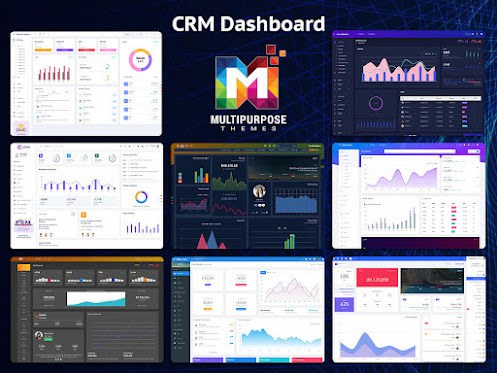
Customer relationship management (CRM) software is essential for managing interactions with customers and prospects. However, the data collected in CRM systems is only useful if it can be analyzed and acted upon. This is where CRM Dashboard come in.
CRM Platform Dashboard visualize CRM data through charts, graphs, and key performance indicators, providing real-time insights into sales activities, marketing campaigns, customer service metrics, and more. Well-designed CRM dashboards empower employees to make better decisions and optimize processes. When integrated properly, they become an invaluable asset that drives business growth.
#CRM Dashboard#CRM Platform Dashboard#CRM Admin Dashboard Template#CRM UI framework#Sales CRM Dashboard#CRM Software Dashboard#CRM Admin Panel Dashboard#CRM Dashboard Ui Kit#CRM Project Dashboard
0 notes
Text
How MVP Development Agencies Help Startups Launch Faster
How MVP Development Agencies Help Startups Launch Faster
Time is the ultimate currency in the startup world. Every delay costs market share, funding opportunities, and early adopter interest. That’s why partnering with high-performance MVP development agencies is one of the smartest moves a founder can make.
But what do these agencies actually do to accelerate your launch? How do they compress timelines without compromising quality?
In this article, we break down how modern MVP development agencies like CloudAstra enable startups to go from idea to launch—faster, leaner, and smarter.
1. Ready-Made Product Frameworks
Speed starts with reusable frameworks. Top MVP development agencies don’t reinvent the wheel—they use boilerplate architectures and pre-built modules to fast-track common features:
Auth systems
Admin dashboards
Payment gateways
Analytics integrations
CloudAstra’s battle-tested MVP kits reduce build time by up to 40%, letting startups focus on innovation instead of infrastructure.
2. Agile Sprints and Rapid Prototyping
Time-boxed development sprints and clickable prototypes allow for early feedback and real-time pivots. This iterative workflow enables founders to refine the product before committing to full builds.
With CloudAstra’s MVP development services, clients get Figma wireframes, sprint demos, and user feedback loops in less than a week—ensuring continuous alignment with product-market fit.
3. Cross-Functional Teams
Modern MVP development agencies deploy cross-functional teams including:
Product managers
UI/UX designers
Backend and frontend engineers
QA and DevOps experts
This structure eliminates delays caused by handoffs or role gaps. CloudAstra’s team structure ensures end-to-end ownership of each feature—from idea to deploy.
4. Infrastructure as Code
Manual configuration is the enemy of speed. CloudAstra uses Terraform and Helm Charts to spin up infrastructure automatically, meaning your staging and production environments are ready in minutes.
This is why MVP development agencies with DevOps muscle are outperforming traditional development shops in launch speed.
5. Launch-Ready MVPs with Growth Hooks
Launching faster isn’t just about writing code—it’s about launching smart. CloudAstra integrates:
Early analytics tools (Hotjar, Mixpanel)
User feedback forms
Newsletter capture
CRM integrations
That’s why the MVPs built by CloudAstra are not just MVPs—they’re growth-ready platforms.
Final Thoughts
If you’re racing against time to launch, MVP development agencies like CloudAstra are the ultimate growth enabler. You’ll get a lean, scalable, launch-ready MVP—built by people who understand startups.
If you're ready to launch smartly, CloudAstra is ready to help.
#mvp#mvp development#mvp development service#mvp development services#mvpdevelopment#mvpdevelopmentservices#mvp software development agency
0 notes
Text
In the early stages of business, a simple CRM tool often feels like a miracle. It helps you track leads, store customer data, and manage your interactions without much fuss. But as your business expands, that once-efficient tool may begin to feel more like a constraint than a solution. What was once enough to get by might now be holding you back.
Modern growth demands more sophisticated systems that go beyond managing contact lists. Businesses require deeper automation, insightful analytics, scalable integrations, and seamless collaboration. If your current CRM feels like it’s lagging behind your operational pace, it may be time to consider a more advanced, tailored approach.
Your CRM Feels Like a Spreadsheet with Fancy Features If using your CRM feels eerily similar to updating Excel sheets, it’s a red flag. Many entry-level tools offer basic tracking without truly streamlining your workflow. You’re spending too much time on manual updates, hunting for scattered data, or copy-pasting between tools.
An effective CRM should reduce admin work, not replicate it. Once you find yourself buried in repetitive tasks, it’s a clear sign your system lacks the automation and sophistication your growing business needs.
Limited Customization Is Blocking Productivity As businesses mature, so do their processes. What worked during the startup phase may no longer suit a scaling operation. If your CRM restricts how you structure pipelines, assign permissions, or create custom workflows, it becomes more of an obstacle than an enabler.
The right solution should mold itself to your business, not the other way around. Modern platforms allow deep customization, which supports specific industry needs and departmental nuances.
Data Silos Are Becoming the Norm Your sales team uses the CRM. Marketing uses another tool. Customer support? Probably relying on emails and spreadsheets. When departments work in isolation, data becomes fragmented.
Without a single source of truth, it’s difficult to get a 360-degree view of customer interactions. This disjointed communication can damage the customer experience and reduce internal efficiency. A more integrated system enables alignment across teams and fosters a unified strategy.
Reporting Feels Like Pulling Teeth If generating reports from your CRM involves exporting data, manually creating graphs, or compiling information from various sources, you’re working too hard.
Advanced systems offer real-time dashboards, predictive analytics, and customizable reporting that empower decision-makers with immediate insights. These capabilities become essential as you scale, helping you react faster and strategize smarter.
Mobile Access Is Either Clunky or Absent A modern workforce is mobile. Your team needs to access critical information on the go – whether in a client meeting, at a trade show, or working remotely.
If your CRM doesn’t offer a fluid mobile experience or limits functionality outside the office, it’s falling short. The inability to stay connected from anywhere is a productivity killer in today’s fast-paced environment.
The CRM Slows Down as You Grow Basic CRM tools often aren’t built for scale. As your contact lists grow, workflows become more complex, and integrations expand, performance may suffer.
Frequent lagging, data syncing issues, and feature limitations can create operational bottlenecks. A scalable infrastructure becomes critical when your business reaches this stage, demanding a solution designed for enterprise-level use.
You’re Still Handling Tasks Manually That Should Be Automated If your team is manually assigning leads, sending follow-up emails, or updating statuses, you’re missing out on the power of automation. These tasks, while minor individually, add up to hours of lost productivity.
Smarter systems can automate customer journeys, trigger responses based on behaviours, and nurture leads with minimal intervention freeing your team to focus on strategy, not process.
Integrating Other Tools Feels Like an Engineering Project Your CRM should act as the hub of your tech stack. Whether it’s marketing automation, invoicing, support platforms, or your ERP – smooth integration is essential.
If syncing tools feels like reinventing the wheel each time, or if you’re constantly working around compatibility issues, it’s a sure sign that your CRM isn’t playing well in the digital ecosystem. A system built with interoperability in mind is crucial for long-term growth.
Customer Insights Are Incomplete Understanding the customer journey is vital. If your current CRM only shows a snapshot perhaps a sales interaction but not support history or marketing touchpoints – you’re missing valuable context.
A comprehensive CRM should aggregate data across channels and departments to offer holistic insights. These insights fuel personalization, better service, and ultimately, stronger relationships.
Your Team Actively Avoids Using the CRM Perhaps the most glaring sign of all: if your team dreads logging into the CRM or frequently bypasses it altogether, it’s time for a change. Tools should make work easier, not harder.
Poor user interfaces, confusing navigation, or lack of relevant features can kill adoption. A new solution should prioritize usability and align with how your team actually works.
Moving Beyond Basic: What to Look for Next Outgrowing a basic CRM is a positive sign – proof that your business is evolving. The next step is investing in a platform that grows with you. Consider:
Advanced automation features Customizable dashboards and workflows AI-driven analytics Deep integration with ERP systems Scalable cloud infrastructure Strong support and training resources At this stage, consulting with a seasoned development partner makes all the difference. Whether you need a bespoke CRM system or want to integrate CRM functionality into an ERP framework, expert guidance ensures a smooth, future-proof transition.
Conclusion: Time to Elevate Your Operations Outgrowing your CRM is not a setback – it’s an opportunity. Recognizing the signs early helps you stay ahead of inefficiencies, empower your teams, and deliver exceptional customer experiences.
Rather than patching over limitations, consider a purpose-built solution that aligns with your strategic goals. The right partner, be it a CRM or ERP software development company will help you architect a system that turns complexity into clarity and growth into a repeatable process.
Your CRM should evolve with your business. If it’s not, it’s time to rethink what your technology should do for you.
1 note
·
View note
Text
Close Deals Faster: How AI-Powered Mobile CRMs Are Reinventing Real Estate Sales

The real estate industry thrives on timing, communication, and insight — and mobile CRMs powered by AI are turning these into real-time advantages.
Agents are no longer tethered to their desks or buried in spreadsheets. With AI-enhanced mobile CRM apps, they’re empowered to respond instantly, prioritize leads, and personalize outreach — anytime, anywhere.
Here’s how AI is transforming mobile CRMs into deal-closing machines for today’s property professionals.
Why Mobile CRM Apps Matter in Real Estate
Mobile CRMs bring all your contacts, property data, follow-ups, and documents into one place — accessible on the go. But when infused with AI, they go from functional to predictive and strategic.
Agents can work smarter, not harder, with intelligent reminders, data-backed lead scoring, and next-best-action insights — driving faster response times and higher conversion rates.
7 Ways AI-Powered Mobile CRMs Boost Real Estate Success
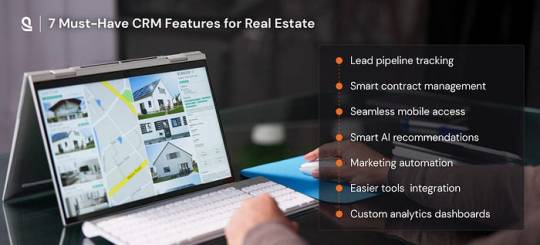
Lead Scoring & Prioritization AI analyzes behavior, engagement, and demographics to rank leads based on likelihood to convert, so agents focus where it counts.
Smart Follow-Ups Predictive reminders and automated outreach help agents engage consistently without missing key opportunities.
Hyper-Personalized Recommendations AI uses past interactions and preferences to suggest relevant properties to each lead, turning data into relevance.
Faster Response Times On-the-go notifications and AI chat assistants help agents reply to inquiries instantly — before the competition does.
Client Behavior Tracking Mobile CRMs track clicks, page views, saved listings, and more, giving agents a window into what clients truly want.
Workflow Automation From scheduling to documentation, AI handles repetitive tasks so agents can focus on negotiation and closing.
Data-Driven Deal Forecasting AI models analyze deal stages, client sentiment, and timelines to predict which leads are likely to convert soon.
Advantages of Custom Mobile CRM Apps with AI Capabilities
Generic CRM solutions often lack flexibility. Custom-built mobile CRM apps tailored to real estate businesses offer:
Brand-specific UX and user flows
Custom dashboards for agents, brokers, or admins
Integrated MLS/IDX feeds for real-time property sync
AI models trained on your internal data for accurate lead scoring
Offline mode access — perfect for on-site visits or rural properties
Role-based permissions and security layers
Multi-platform support (Android, iOS, Web)
Custom CRMs ensure that you’re not adapting your process to software — instead, your software adapts to you.
Read full Blog 👉 Click Here
0 notes
Text
Why AI Tools Are a Must-Have for Small Business Owners in the Post-Pandemic Market
The business landscape has changed dramatically post-pandemic, with digital transformation moving from a luxury to a necessity. In 2025, AI tools for small business owners are no longer optional—they are essential to compete, adapt, and grow in a market shaped by automation, data, and changing consumer behavior.
Small business owners are using AI tools to streamline everything from customer support and content generation to inventory tracking and financial forecasting. These tools not only reduce operational burdens but also offer real-time insights that drive smarter decisions. With just a few clicks, owners can generate reports, predict sales trends, or automate customer queries, saving both time and money.
Unlike in the past, today’s AI tools are accessible even to non-tech-savvy users. Platforms come with intuitive dashboards, helpful tutorials, and integrations that connect with existing systems like CRMs and eCommerce platforms. This makes implementation seamless and scalable, regardless of the size or stage of your business.
For entrepreneurs navigating uncertainty and rapid change, AI tools for small business owners offer stability and efficiency. They allow founders to work smarter, respond faster, and focus more on innovation and strategy instead of routine admin work.
0 notes
Text
Training the Next Generation of Pharma Sales Reps: 10 Essentials for High-Impact Performance
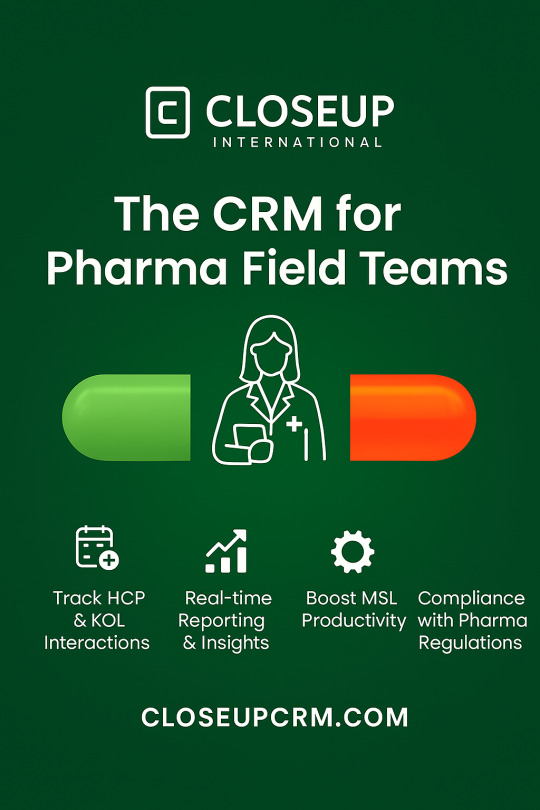
In today’s competitive, fast-evolving pharmaceutical landscape, sales reps must be far more than product messengers. The next generation of pharma sales professionals needs to be well-rounded, digitally fluent, emotionally intelligent, and always learning.
Whether you're onboarding new hires or upskilling experienced teams, here are 10 essential pillars to build a high-performing, future-ready salesforce — powered by real-world tools like CloseupCRM.com.
1️⃣ Start with a Strong Foundation: Clinical Knowledge
Sales reps must understand their products on a deep, clinical level — not just memorized talking points. Training should cover:
Mechanism of action (MoA)
Indications, contraindications, and side effects
Product comparisons with competitors (efficacy, safety, cost)
💡 Pro Tip: Involve Medical Science Liaisons (MSLs) early to provide real-world clinical context and confidence in complex discussions.
2️⃣ Go Beyond the Product: Disease-State Education
A well-informed rep must grasp the broader therapeutic landscape, including:
Diagnostic criteria
Treatment pathways
Existing gaps in care
Understanding the disease — not just the drug — helps reps have meaningful, relevant conversations with HCPs and positions them as trusted partners.
3️⃣ Embrace Digital & Hybrid Selling Skills
With limited in-person access to HCPs, digital fluency is no longer optional:
Master CRM tools and virtual platforms
Personalize outreach via email, SMS, or video
Use omnichannel touchpoints to stay top of mind
Interpret engagement data using CRM dashboards
💡 Tools like CloseupCRM.com allow reps to track engagement, plan smarter follow-ups, and deliver seamless hybrid selling experiences.
4️⃣ Build Soft Skills & Emotional Intelligence
Empathy, adaptability, and active listening often distinguish top reps from average ones. Training should include:
Communication workshops
Objection handling and rapport-building exercises
Reading body language — in-person and virtually
💬 EQ helps reps connect, adjust their tone, and build long-term HCP relationships. CRM insights can support this personalization.
5️⃣ Emphasize Compliance & Ethics
Ethical selling is non-negotiable. Reps must fully understand:
The PhRMA Code and Sunshine Act
Company-specific compliance rules
Legal dos and don’ts around HCP interactions
Make training interactive and ongoing, with real-world case studies. Platforms like CloseupCRM.com provide a transparent way to log visits and maintain regulatory integrity.
6️⃣ Master Territory & Time Management
Reps must plan their time and territory strategically to get the most out of every day:
Segment and prioritize HCPs
Optimize travel routes and call schedules
Use CRM tools for visit planning and tracking
Block time for admin, follow-ups, and learning
⏱️ CloseupCRM enables efficient visit planning and territory mapping, helping reps stay focused and proactive.
7️⃣ Encourage Continuous Learning & Mentorship
Pharma is constantly changing — so reps should never stop learning:
Promote bite-sized learning via podcasts, webinars, articles
Implement peer mentorship and manager shadowing
Conduct regular call reviews and ride-alongs for feedback
📈 Use CRM platforms to track engagement with learning content and share new product updates or scientific resources directly with the field.
8️⃣ Train Reps to Tell Scientific Stories, Not Just Features
Today’s HCPs want patient-centered, evidence-based conversations, not sales scripts. Teach reps to frame messages as:
A clinical challenge
The patient’s journey
Your product’s impact
The supporting data
Use storytelling workshops and CRM history (e.g., past HCP questions or interests) to help reps tailor each message. CloseupCRM.com supports message relevance by capturing prior engagements.
9️⃣ Use Data to Drive Smarter Selling
Top reps don’t just guess — they use data to guide strategy:
Interpret dashboards and performance metrics
Track HCP engagement levels
Identify gaps in call frequency or follow-ups
Adjust tactics in real time
CRM platforms like CloseupCRM.com empower reps to make data-driven decisions that lead to higher-quality interactions.
🔟 Create a Feedback Culture for Long-Term Success
Reps grow fastest when feedback is frequent, specific, and actionable:
Schedule regular coaching sessions with managers
Encourage peer feedback and team learning
Normalize asking for input and learning from mistakes
🧠 Use CRM data to provide context-rich feedback — e.g., how messaging affected HCP behavior or which visits led to positive follow-ups.
✅ Final Thoughts
Training pharma reps today requires more than product slides and compliance checklists. It’s about building a dynamic, agile, and people-first salesforce. By emphasizing soft skills, digital tools, clinical depth, and continuous learning — supported by smart platforms like CloseupCRM.com — organizations can develop the next generation of high-impact sales professionals who sell ethically, connect meaningfully, and adapt fearlessly.
0 notes
Text
WeKwick: The Smart Way to Create a Free Website for Your Business
WeKwick is a platform designed to help small businesses come online and grow without needing technical skills or high budgets. Whether you’re selling homemade products, offering professional services, or running a local store, WeKwick makes it easy to create a website and manage your business digitally.
With a range of built-in tools like product management, lead capture, and design templates, you can build a fully functional website in just a few steps. If you’re looking to create a free website for your business, this guide explains how WeKwick can help — and why it’s considered one of the best ecommerce website builders for small business.
Key Features That Make WeKwick Ideal for Small Businesses
1. Custom Domain Branding
Make your business look more professional by connecting your own domain name. A personalized domain helps build trust, improves visibility, and adds credibility to your online presence.
2. Beautiful Landing Page Designs
Create an impressive first impression with professionally designed landing pages. You can showcase your business, highlight key services or products, and guide users to take action — all without needing a designer.
3. Support for Multi-Page Websites
You’re not limited to a single-page site. With WeKwick, you can create multiple pages such as Home, About, Services, Products, Contact, and more. This allows you to provide detailed information about your business.
4. Smart Contact Forms
WeKwick includes mobile-friendly and customizable contact forms. These forms make it easy to collect inquiries, feedback, and service requests from customers on any device.
5. Multi-User Roles & Permissions
If you’re working with a team, you can assign different roles — like Admin, Manager, or Editor — based on responsibilities. This improves workflow and keeps your site secure and organized.
6. Real-Time Email Notifications
Whenever a visitor fills out a form or makes a purchase, you’ll receive an instant email alert. This helps you respond quickly and maintain good customer relationships.
7. Advanced Stock Management
Managing inventory is simple with WeKwick. You can track stock levels, receive low-stock alerts, and keep your online store updated without manual spreadsheets.
8. Dedicated Customer Support
Whenever you face a challenge or need guidance, WeKwick provides timely help through its support system. Whether it’s domain setup or design queries, assistance is just a message away.
9. Instant Website Design Switching
Want to refresh your site’s look? You can switch between designs instantly without affecting your content or structure. This helps you keep your website updated with minimal effort.
10. Google Calendar Integration
For businesses that run appointments or events, integrating with Google Calendar helps sync and manage schedules automatically.
11. 3rd Party Integrations
WeKwick supports multiple third-party tools — like CRMs, payment gateways, and analytics. This lets you customize your workflow and business tools the way you want.
12. Meta Leads Integration
If you’re running ads on Facebook or Instagram, you can directly capture leads into your WeKwick dashboard using Meta Lead integration. No need for extra tools or manual exports.
13. Email Marketing Tools
From your WeKwick dashboard, you can send newsletters, promotions, and updates to your subscribers. There’s no need for external marketing software.
14. Display Google Reviews
Your real-time Google reviews can be showcased directly on your website. This helps build trust and shows proof of customer satisfaction.
15. Smart Inventory Tools
For e-commerce sellers, WeKwick provides a detailed product management system. You can edit product details, update prices, track quantity, and manage listings easily.
Why WeKwick Stands Out
WeKwick isn’t just a website builder — it’s a complete solution for small business owners who want to go digital. From the moment you create your account to the day you make your first sale, the platform supports your business every step of the way.
If you want to create a free website for your business or are exploring the best ecommerce website builder for small business, WeKwick provides a practical, beginner-friendly way to get started.
FAQs About WeKwick
Q1. Who can use WeKwick? Anyone who wants to take their small business online — whether you’re a product seller, freelancer, service provider, or consultant.
Q2. Is it really free to create a website? Yes. You can start for free and upgrade only if you need additional features like custom domains or priority support.
Q3. Can I sell products through my website? Yes. WeKwick includes tools for adding products, managing inventory, accepting payments, and fulfilling orders.
Q4. Do I need to know coding or design? No. Everything on WeKwick is drag-and-drop. Templates and tools are made for non-technical users.
Q5. Can I connect my own domain? Yes, you can connect your custom domain at any time to create a professional web presence.
Q6. Does it work on mobile devices? Yes. All websites created with WeKwick are fully responsive and mobile-friendly.
Final Thoughts
Getting your business online shouldn’t be complicated or expensive. With WeKwick, you can build your website, sell online, and manage everything from one place. It’s a simple, flexible solution for anyone who wants to build a modern digital presence — quickly and affordably.
Ready to begin? Create your free business website today and take the first step toward building your brand online.
0 notes